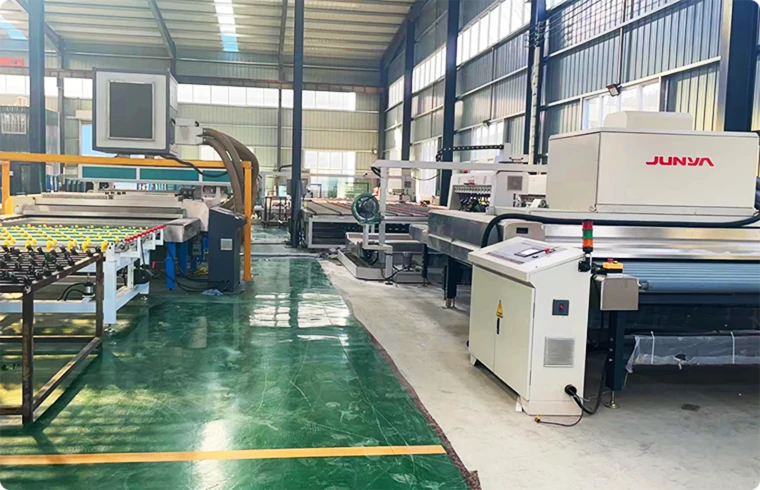The Process of Making Toughened Glass
Toughened glass, also known as tempered glass, is widely used in various applications due to its enhanced strength and safety features
. The manufacturing process of toughened glass involves several key steps designed to increase its durability and resistance to thermal stress.
The journey begins with the selection of raw materials, primarily silica sand, soda ash, and limestone. These materials are combined and melted at high temperatures, reaching around 1,700 degrees Fahrenheit (about 927 degrees Celsius), to form a molten glass. This molten glass is then formed into sheets of desired thickness using processes like float glass technology, where the glass is floated on molten tin to create a smooth surface.
Once the glass sheets are shaped and cooled, they undergo the toughening process. This involves heating the glass to a temperature of approximately 1,200 degrees Fahrenheit (about 649 degrees Celsius). At this stage, the glass is carefully heated in a controlled environment, allowing it to reach a uniform temperature without creating any stress points. The goal is to ensure the entire sheet of glass is evenly heated.
process of making toughened glass
After achieving the desired temperature, the glass is rapidly cooled through a process known as quenching. This involves blowing cold air onto the surface of the glass to rapidly lower its temperature. The outer layer of the glass cools and contracts faster than the inner part, creating compressive stresses on the surface, which significantly increases its strength. This method of tempering not only enhances the glass's mechanical properties but also makes it more resistant to breakage from impacts and thermal shock.
One of the most fascinating aspects of toughened glass is its safety feature. If breakage does occur, toughened glass shatters into small, blunt pieces rather than sharp shards, reducing the risk of injury. This quality makes toughened glass an ideal choice for a variety of applications, including windows, shower doors, glass doors, and facades for buildings.
In addition to its safety and strength, toughened glass can be treated with coatings for added functionalities, such as solar control or anti-reflective properties. The versatility of toughened glass makes it a popular choice across many industries, including architecture, automotive, and even consumer products.
In conclusion, the process of making toughened glass involves a combination of high-temperature melting, controlled heating, and rapid cooling to create a material that is not only robust but also adds a layer of safety in case of breakage. This innovative manufacturing process has paved the way for the widespread use of toughened glass in modern design and architecture.
 Afrikaans
Afrikaans  Albanian
Albanian  Amharic
Amharic  Arabic
Arabic  Armenian
Armenian  Azerbaijani
Azerbaijani  Basque
Basque  Belarusian
Belarusian  Bengali
Bengali  Bosnian
Bosnian  Bulgarian
Bulgarian  Catalan
Catalan  Cebuano
Cebuano  Corsican
Corsican  Croatian
Croatian  Czech
Czech  Danish
Danish  Dutch
Dutch  English
English  Esperanto
Esperanto  Estonian
Estonian  Finnish
Finnish  French
French  Frisian
Frisian  Galician
Galician  Georgian
Georgian  German
German  Greek
Greek  Gujarati
Gujarati  Haitian Creole
Haitian Creole  hausa
hausa  hawaiian
hawaiian  Hebrew
Hebrew  Hindi
Hindi  Miao
Miao  Hungarian
Hungarian  Icelandic
Icelandic  igbo
igbo  Indonesian
Indonesian  irish
irish  Italian
Italian  Japanese
Japanese  Javanese
Javanese  Kannada
Kannada  kazakh
kazakh  Khmer
Khmer  Rwandese
Rwandese  Korean
Korean  Kurdish
Kurdish  Kyrgyz
Kyrgyz  Lao
Lao  Latin
Latin  Latvian
Latvian  Lithuanian
Lithuanian  Luxembourgish
Luxembourgish  Macedonian
Macedonian  Malgashi
Malgashi  Malay
Malay  Malayalam
Malayalam  Maltese
Maltese  Maori
Maori  Marathi
Marathi  Mongolian
Mongolian  Myanmar
Myanmar  Nepali
Nepali  Norwegian
Norwegian  Norwegian
Norwegian  Occitan
Occitan  Pashto
Pashto  Persian
Persian  Polish
Polish  Portuguese
Portuguese  Punjabi
Punjabi  Romanian
Romanian  Russian
Russian  Samoan
Samoan  Scottish Gaelic
Scottish Gaelic  Serbian
Serbian  Sesotho
Sesotho  Shona
Shona  Sindhi
Sindhi  Sinhala
Sinhala  Slovak
Slovak  Slovenian
Slovenian  Somali
Somali  Spanish
Spanish  Sundanese
Sundanese  Swahili
Swahili  Swedish
Swedish  Tagalog
Tagalog  Tajik
Tajik  Tamil
Tamil  Tatar
Tatar  Telugu
Telugu  Thai
Thai  Turkish
Turkish  Turkmen
Turkmen  Ukrainian
Ukrainian  Urdu
Urdu  Uighur
Uighur  Uzbek
Uzbek  Vietnamese
Vietnamese  Welsh
Welsh  Bantu
Bantu  Yiddish
Yiddish  Yoruba
Yoruba  Zulu
Zulu 

